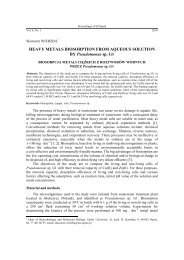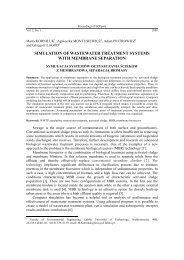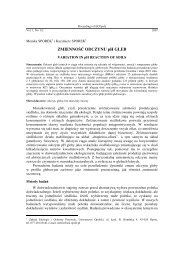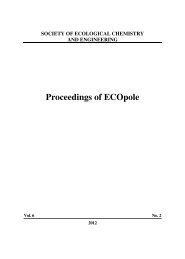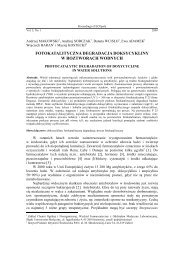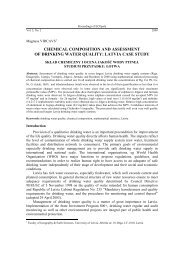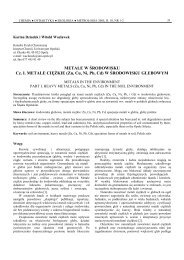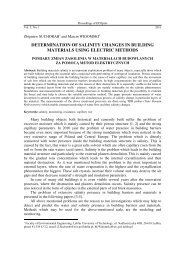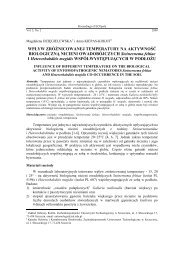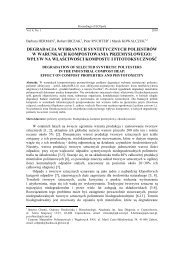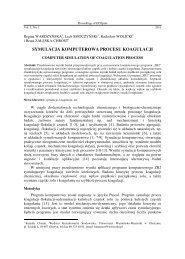life cycle assessment of sulphonate derivative of polystyrene waste ...
life cycle assessment of sulphonate derivative of polystyrene waste ...
life cycle assessment of sulphonate derivative of polystyrene waste ...
Create successful ePaper yourself
Turn your PDF publications into a flip-book with our unique Google optimized e-Paper software.
Proceedings <strong>of</strong> ECOpole<br />
Vol. 2, No. 1 2008<br />
Wioletta M. BAJDUR 1 and Anna HENCLIK 2<br />
LIFE CYCLE ASSESSMENT OF SULPHONATE DERIVATIVE<br />
OF POLYSTYRENE WASTE USED<br />
IN SEWAGE COAGULATION PROCESS<br />
EKOLOGICZNA OCENA CYKLU śYCIA POCHODNEJ SULFONOWEJ<br />
ODPADÓW POLISTYRENOWYCH ZASTOSOWANEJ<br />
W PROCESIE KOAGULACJI ŚCIEKÓW<br />
Summary: Intensive scientific researches on <strong>waste</strong> materials utilisation as source <strong>of</strong> recyclable materials and in<br />
particular in chemical and energy industries have been carried out around the world and particularly in<br />
industrialised countries since mid-seventies <strong>of</strong> past century. Contemporary technique allows proposing <strong>waste</strong><br />
management solutions nearly in each technology. Yet, it is necessary to consider ecological and also economical<br />
conditions. Production cost <strong>of</strong> recyclable products is calculated on basis <strong>of</strong> capital expenditures and operational<br />
costs <strong>of</strong> <strong>waste</strong>s processing. Assessment <strong>of</strong> <strong>waste</strong> management technology influence on environment can be carried<br />
out with use <strong>of</strong> available techniques <strong>of</strong> environmental management - Life Cycle Assessment (LCA). LCA is<br />
relatively new technique <strong>of</strong> environmental aspects <strong>assessment</strong>; it forms grounds for identification, hierarchy and<br />
also arrangements concerning ways <strong>of</strong> improvement <strong>of</strong> environment quality. One <strong>of</strong> the basic LCA tasks is<br />
examining potential product or product's system influence on environment during the whole <strong>life</strong> <strong>cycle</strong>: from raw<br />
materials extraction through production and use untill utilisation. Carrying out researches and analysis with use <strong>of</strong><br />
LCA technique allows to manage resources in effective way because it is based on real input and output data <strong>of</strong><br />
analysed processes. Correctly performed LCA analysis should include four phases: 1 - establishing the aim and the<br />
scope <strong>of</strong> the research, 2 - forming input and output database - inventory (system balance analysis, data inventory),<br />
3 - <strong>assessment</strong> <strong>of</strong> <strong>life</strong> <strong>cycle</strong> impact, 4 - interpretation <strong>of</strong> the results. In article the authors present the LCA analysis<br />
for production <strong>of</strong> sodium salt <strong>of</strong> <strong>sulphonate</strong> <strong>derivative</strong> <strong>of</strong> <strong>polystyrene</strong> <strong>waste</strong> materials, which would be used in<br />
coagulation process <strong>of</strong> selected municipal and industrial <strong>waste</strong>s. The aim <strong>of</strong> LCA analysis is the <strong>assessment</strong> <strong>of</strong><br />
influence on environment <strong>of</strong> developed new technology <strong>of</strong> selected processes, which consists <strong>of</strong> chemical<br />
modification <strong>of</strong> <strong>polystyrene</strong> <strong>waste</strong>s and receiving new flocculants types. Researches scope includes modification<br />
process <strong>of</strong> crumbled <strong>polystyrene</strong> <strong>waste</strong>s for receiving sodium salt <strong>of</strong> <strong>sulphonate</strong> <strong>derivative</strong> <strong>of</strong> <strong>polystyrene</strong> (<strong>of</strong> <strong>waste</strong><br />
materials) and next its application to coagulation process. Technological assumptions <strong>of</strong> developed technology<br />
became basis to creation <strong>of</strong> inventory tables, and then to <strong>assessment</strong> <strong>of</strong> the potential influence on environment with<br />
LCA technique using SimaPro. Received data are the basis to ecological and economical <strong>assessment</strong> <strong>of</strong> <strong>of</strong>fered new<br />
technological solutions.<br />
Keywords: LCA, <strong>polystyrene</strong> <strong>waste</strong> materials, sewage treatment, flocculants<br />
Plastic <strong>waste</strong> is currently a major source <strong>of</strong> recycling materials. One <strong>of</strong> many types <strong>of</strong><br />
<strong>waste</strong> is foamed <strong>polystyrene</strong> <strong>waste</strong> (packaging, trays, cups), which is a valuable source <strong>of</strong><br />
recyclable raw materials.<br />
For the last few years an attempt to obtain usable products from the above-mentioned<br />
<strong>waste</strong> types has been made. The result <strong>of</strong> this research was the producing (during the<br />
process <strong>of</strong> chemical modification <strong>of</strong> foamed <strong>polystyrene</strong>) <strong>of</strong> substances enhancing the<br />
coagulation process, ie flocculants. Modifying foamed <strong>polystyrene</strong> <strong>waste</strong> in order to obtain<br />
effective polyelectrolytes appeared to be the right way to enhance the effectiveness <strong>of</strong> <strong>waste</strong><br />
treatment processes [1-9].<br />
1<br />
Faculty <strong>of</strong> Management, Czestochowa University <strong>of</strong> Technology, Armii Krajowej 36B, 42-200 Częstochowa,<br />
email: wiolawb@poczta.onet.pl<br />
2<br />
Mineral and Energy Economy Research Institute, Polish Academy <strong>of</strong> Sciences, J. Wybickiego 7, 31-261<br />
Kraków, email: ahenclik@min-pan.krakow.pl
10<br />
Wioletta M. Bajdur and Anna Henclik<br />
This article discusses the results <strong>of</strong> a study testing the influence exerted by the process<br />
<strong>of</strong> <strong>waste</strong> coagulation on the environment using the newly developed technology <strong>of</strong><br />
obtaining <strong>sulphonate</strong> <strong>derivative</strong>s from <strong>polystyrene</strong> <strong>waste</strong>. In order to achieve this, the<br />
relatively new method <strong>of</strong> Life Cycle Assessment (LCA) was used. LCA forms the grounds<br />
for the identification, hierarchisation and determination <strong>of</strong> methods to improve the<br />
environmental quality. One <strong>of</strong> the major tasks <strong>of</strong> LCA is to examine the potential impact <strong>of</strong><br />
a product or a production process on the environment, during the whole <strong>life</strong> <strong>cycle</strong> <strong>of</strong> the<br />
product, from the moment <strong>of</strong> raw material extraction, through the production, operational<br />
use, until its utilization. Performing analyses according to LCA principles allows the<br />
effective management <strong>of</strong> resources in respect to ecology, since this method relies on real<br />
input and output data <strong>of</strong> the given process [10, 11].<br />
In this article an LCA analysis was carried out for the coagulation process <strong>of</strong> liquid<br />
industrial <strong>waste</strong>s, mine water from the „Wesoła” mine, using a new type <strong>of</strong> flocculant -<br />
sodium salt <strong>of</strong> the <strong>sulphonate</strong> <strong>derivative</strong> from <strong>polystyrene</strong> <strong>waste</strong>.<br />
Materials and methods<br />
A <strong>derivative</strong> <strong>of</strong> the highest percentage <strong>of</strong> sulphur content was selected for the test, this<br />
<strong>derivative</strong> was obtained as a result <strong>of</strong> a synthesis reaction, using foamed <strong>polystyrene</strong> <strong>waste</strong><br />
(food trays) and sulphuric acid, calcium carbonate and sodium carbonate. The selection <strong>of</strong><br />
the most efficient product was carried out by performing a test <strong>of</strong> flocculation using<br />
aluminium sulphate as the coagulant and mine water from the „Wesoła” mine.<br />
The <strong>sulphonate</strong> <strong>derivative</strong> from foamed <strong>polystyrene</strong> <strong>waste</strong> was obtained by the<br />
sulphonation <strong>of</strong> foamed <strong>polystyrene</strong> <strong>waste</strong> with concentrated H2SO4 acid, according to the<br />
commonly known method <strong>of</strong> aromatic compound sulphonation. In order to remove excess<br />
sulphuric acid, the process <strong>of</strong> deacidification with CaCO3 was performed and its products<br />
were precipitated in a form <strong>of</strong> sodium salts in a reaction with Na2CO3.<br />
In order to test the flocculation properties <strong>of</strong> the <strong>sulphonate</strong> <strong>derivative</strong> from foamed<br />
<strong>polystyrene</strong> <strong>waste</strong>, a process using a 1% solution <strong>of</strong> the coagulant and a 0.1% solution <strong>of</strong><br />
the obtained polyelectrolyte was performed. Upon selection <strong>of</strong> a certain type <strong>of</strong> <strong>sulphonate</strong><br />
<strong>derivative</strong> from <strong>polystyrene</strong> <strong>waste</strong>, an evaluation <strong>of</strong> the influence <strong>of</strong> liquid <strong>waste</strong> treatment<br />
using the new type <strong>of</strong> flocculant on the environment was performed in accordance with<br />
LCA. The carried out evaluation included four phases: 1 - Goal and Scope, 2 - Life Cycle<br />
Inventory, 3 - Life Cycle Impact Assessment, 4 - Interpretation.<br />
As the goal <strong>of</strong> the analysis, the establishment <strong>of</strong> the influence <strong>of</strong> liquid <strong>waste</strong> treatment<br />
with the new type <strong>of</strong> flocculant on the environment was chosen. The range <strong>of</strong> the research<br />
included the process <strong>of</strong> the chemical modification <strong>of</strong> crumbled <strong>polystyrene</strong> <strong>waste</strong> resulting<br />
in the obtainment <strong>of</strong> a sodium salt <strong>of</strong> a <strong>sulphonate</strong> <strong>derivative</strong> from <strong>polystyrene</strong> <strong>waste</strong>, and<br />
then using it in the coagulation process.<br />
The technological assumptions <strong>of</strong> the new type <strong>of</strong> flocculant production become the<br />
basis <strong>of</strong> inventory table creation, based on which the potential influence on the environment<br />
was assessed in accordance with the LCA technique, using the SimaPro program.<br />
Discussion <strong>of</strong> results<br />
The chemical modification <strong>of</strong> foamed <strong>polystyrene</strong> <strong>waste</strong> performed in an excess <strong>of</strong><br />
sulphuric acid enabling the obtainment <strong>of</strong> a <strong>sulphonate</strong> <strong>derivative</strong> <strong>of</strong> a maximal sulphur
Life <strong>cycle</strong> <strong>assessment</strong> <strong>of</strong> <strong>sulphonate</strong> <strong>derivative</strong> <strong>of</strong> <strong>polystyrene</strong> <strong>waste</strong> used in sewage coagulation process<br />
content <strong>of</strong> 13.80% which equals the content <strong>of</strong> one sulphonic group per one constitutional<br />
unit. For the product obtained from <strong>polystyrene</strong> <strong>waste</strong>, a test <strong>of</strong> the flocculation process for<br />
the chosen liquid <strong>waste</strong> - mine water from the „Wesoła” mine was performed.<br />
This water was selected based on the fact that <strong>sulphonate</strong> <strong>derivative</strong>s from foamed<br />
<strong>polystyrene</strong> <strong>waste</strong> are polyelectrolytes <strong>of</strong> an anionic type, and such polyelectrolytes are<br />
most usable to support the coagulation processes <strong>of</strong> industrial sewage.<br />
The chemical application <strong>of</strong> modified foamed <strong>polystyrene</strong> <strong>waste</strong> results not only in<br />
reduction <strong>of</strong> water turbidity, but also in a major decrease <strong>of</strong> most <strong>of</strong> the tested<br />
physicochemical parameters <strong>of</strong> water. The most important and most noticeable in the tested<br />
liquid <strong>waste</strong> are: a decrease <strong>of</strong> sulphate and chloride content and a reduction <strong>of</strong> biochemical<br />
oxygen demand (BOD). The values <strong>of</strong> pollution indices obtained for these waters after<br />
flocculation processes mean that the treated liquid <strong>waste</strong> can be drained into watercourses.<br />
Fig. 1. Simplified diagram <strong>of</strong> processes for „Wesoła” mine water purification, using new type <strong>of</strong> flocculant.<br />
Source: SimaPro<br />
In relation to this, a processing line for the new flocculant production was designed,<br />
this line includes: sulphonators, agitators, filters, pumps and dryers. The assumed<br />
production level was 100 kg per month. The technological assumptions <strong>of</strong> the production <strong>of</strong><br />
new generation polyelectrolytes have become the basis for the creation <strong>of</strong> inventory tables<br />
for the flocculant production and for mine water purification. Based on the inventory tables,<br />
the potential influence <strong>of</strong> the treatment <strong>of</strong> a specified quantity <strong>of</strong> sewage on the<br />
environment was assessed. As a functional unit a twenty-four-hour quantity <strong>of</strong> treated<br />
sewage - ie 20 000 m 3 was chosen. The inventory table <strong>of</strong> the sewage purification process<br />
included: purified sewage, sodium salt <strong>of</strong> the <strong>polystyrene</strong> <strong>derivative</strong>, make-up water,<br />
electrical power and sediment obtained after the sewage treatment.<br />
11
12<br />
Wioletta M. Bajdur and Anna Henclik<br />
Upon entering the data from the inventory table <strong>of</strong> the sewage treatment process,<br />
a diagram <strong>of</strong> raw materials and processes was developed (Fig. 1) using the Eco-indicator<br />
99. The thickness <strong>of</strong> the arrows is relative to the influence on the environment, thus in the<br />
sewage treatment process the decisive factor, potentially burdening the environment, is the<br />
use <strong>of</strong> electrical power during the purification process, while the influence <strong>of</strong> the other<br />
processes is insignificant. The negative value with PS sodium salt proves the positive<br />
influence <strong>of</strong> this product on the environment, which is a result <strong>of</strong> using the PS <strong>waste</strong> for<br />
production.<br />
The results <strong>of</strong> the analysis have also been presented in the form <strong>of</strong> a weighing<br />
histogram (Fig. 2), which places the environmental burdens in 3 categories <strong>of</strong> damage, ie:<br />
• human health<br />
• ecosystem quality<br />
• resources<br />
Fig. 2. Weighing histogram for process <strong>of</strong> treatment <strong>of</strong> 20 000 m 3 sewage, using new type <strong>of</strong> flocculant. Source:<br />
SimaPro<br />
The results <strong>of</strong> the weighing histogram are presented with scores expressed with<br />
so-called points (Pt), where one point equals the average influence exerted by one European<br />
on the environment in a one-year period.<br />
The decisive factor potentially burdening the environment in all the three damage<br />
categories during the sewage treatment process, is the huge consumption <strong>of</strong> electrical<br />
power. Further research should be undertaken to evaluate the possibility <strong>of</strong> reducing<br />
electrical power consumption during the sewage treatment process. In the human health<br />
category another factor <strong>of</strong> a slight effect is the production <strong>of</strong> PS sodium salt, because <strong>of</strong> the<br />
excess <strong>of</strong> sulphuric acid used in this production process, therefore decreasing the sulphuric<br />
acid quantity should also be considered.<br />
The negative value <strong>of</strong> the factor in the resources consumption category results from the<br />
fact <strong>of</strong> saving natural resources, like: natural gas, petroleum used in <strong>polystyrene</strong> production,<br />
since in this production process <strong>polystyrene</strong> <strong>waste</strong> is also used.
Life <strong>cycle</strong> <strong>assessment</strong> <strong>of</strong> <strong>sulphonate</strong> <strong>derivative</strong> <strong>of</strong> <strong>polystyrene</strong> <strong>waste</strong> used in sewage coagulation process<br />
Summary<br />
The development <strong>of</strong> a new type <strong>of</strong> flocculant is an entirely new look upon the sewage<br />
coagulation process. The flocculants currently used are typical, traditional products, which<br />
are produced using primary raw materials. With the current condition <strong>of</strong> the environment<br />
and resource availability, the attempt made to use <strong>waste</strong> from the process <strong>of</strong> production <strong>of</strong><br />
useful products, is favourable both for the environment and the society. Such an approach<br />
to <strong>waste</strong> management is in accordance with the targets <strong>of</strong> European Union policy<br />
concerning preventing <strong>waste</strong> production, its recycling or recovery, in order to reduce its<br />
negative influence on the environment. Another target <strong>of</strong> EU policy is the universal use <strong>of</strong><br />
recycling, enabling the elimination <strong>of</strong> produced <strong>waste</strong>s or to use them as substitutes.<br />
During the carried out research, the huge electrical power consumption <strong>of</strong> the<br />
coagulation process appeared to be the decisive factor potentially burdening the<br />
environment. However, it seems that the level <strong>of</strong> electrical power consumption does not<br />
depend on the type <strong>of</strong> flocculant used.<br />
For the next step, a comparison between the flocculants currently used and those newly<br />
obtained should be made, but the greatest problem here is to obtain data concerning the<br />
technology <strong>of</strong> the currently used flocculants. But the fact that the sodium salt <strong>of</strong><br />
a <strong>sulphonate</strong> <strong>derivative</strong> from <strong>polystyrene</strong> <strong>waste</strong> is produced from a <strong>waste</strong> material prompts<br />
the imposition <strong>of</strong> a thesis that introducing this universally into coagulation processes will<br />
result in the obtainment <strong>of</strong> the most environmentally-friendly technology <strong>of</strong> <strong>waste</strong><br />
treatment.<br />
References<br />
[1] Inagaki Y. et al.: Reclamation <strong>of</strong> <strong>waste</strong> <strong>polystyrene</strong> by sulphonation. Langmuir, 1999, 15, 4171-4175.<br />
[2] Simitzis J. and Fountas D.: Utilization <strong>of</strong> <strong>waste</strong>s foam <strong>polystyrene</strong> as sorbents. J. Appl. Polymer Science,<br />
1995, 55(6), 879-887.<br />
[3] Harland R.S. and Prud’homme R.K.: Polyelectrolytes Gels - Properties, Preparation and Application.<br />
American Chemical Society, Washington DC 1992.<br />
[4] Bajdur W. and Sułkowski W.: Flocculative properties <strong>of</strong> modified expanded <strong>polystyrene</strong> <strong>waste</strong>s. Chem. InŜ.<br />
Ekol., 2000, 7(1-2), 119-127.<br />
[5] Bajdur W. et al.: Effective polyelectrolytes synthesis from expanded <strong>polystyrene</strong> <strong>waste</strong>s. Europ. Polymer J.,<br />
2002, 38, 299-304.<br />
[6] Bajdur W.M. and Sułkowski W.W.: Application <strong>of</strong> modified <strong>waste</strong>s from phenol-formaldehyde resin and<br />
expanded <strong>polystyrene</strong> in sewage treatment processes. Macromolecular Symposia, 2003, 202, 325-337.<br />
[7] Sułkowski W. et al.: Preparation and properties <strong>of</strong> sulphur <strong>derivative</strong>s from <strong>polystyrene</strong> <strong>waste</strong>. Polymer<br />
Degradation and Stability, 90(1) [in press].<br />
[8] March J.: Advanced organic chemistry. Reactions, mechanisms, and structure. Wiley, New York 1992.<br />
[9] Dziennik Ustaw Nr 116 (Polish Acts), Supplement to the Decree <strong>of</strong> the Ministry <strong>of</strong> Environmental<br />
Protection, Natural Resources and Forestry, from 05.11.1991, Data <strong>of</strong> Environmental Pollutant<br />
Concentration in Water [in Polish].<br />
[10] PN-EN ISO 14040:2006 Environmental management - Life <strong>cycle</strong> <strong>assessment</strong> - Principles and framework<br />
(ISO 14040:2006).<br />
[11] PN-EN ISO 14044:2006 Environmental management - Life <strong>cycle</strong> <strong>assessment</strong> - Requirements and guidelines<br />
(ISO 14044:2006).<br />
13
14<br />
Wioletta M. Bajdur and Anna Henclik<br />
EKOLOGICZNA OCENA CYKLU śYCIA POCHODNEJ SULFONOWEJ<br />
ODPADÓW POLISTYRENOWYCH ZASTOSOWANEJ<br />
W PROCESIE KOAGULACJI ŚCIEKÓW<br />
Streszczenie: Od połowy lat 70. ubiegłego stulecia prowadzi się na świecie, szczególnie w krajach<br />
uprzemysłowionych, intensywne badania naukowe nad wykorzystaniem odpadów jako źródła surowców<br />
wtórnych, szczególnie w przemyśle chemicznym i energetycznym. Współczesny rozwój techniki pozwala<br />
zaproponować zagospodarowanie odpadów niemal w kaŜdej technologii. Konieczne jest jednak uwzględnienie<br />
uwarunkowań ekologicznych oraz ekonomicznych. Koszty produkcji wyrobów z surowców wtórnych oblicza się<br />
na podstawie nakładów inwestycyjnych i kosztów eksploatacyjnych przerobu odpadów. Ocenę wpływu na<br />
środowisko technologii zagospodarowania odpadów moŜna prowadzić z wykorzystaniem dostępnych technik<br />
zarządzania środowiskowego - np. oceny cyklu Ŝycia (LCA - Life Cycle Assessment). Ocena cyklu Ŝycia jest<br />
stosunkowo nową techniką oceny aspektów środowiskowych; stwarza ona podstawy do identyfikacji,<br />
hierarchizacji oraz ustalenia sposobów poprawy jakości środowiska. Jednym z podstawowych zadań LCA jest<br />
badanie potencjalnych wpływów wyrobu lub systemu wyrobu na środowisko podczas całego cyklu Ŝycia:<br />
począwszy od pozyskania surowców poprzez produkcję, uŜytkowanie aŜ do utylizacji. Prowadzenie badań i analiz<br />
techniką LCA pozwala na efektywne gospodarowanie zasobami pod względem ekologicznym, poniewaŜ korzysta<br />
się z realnych danych wejściowych i wyjściowych analizowanych procesów. Prawidłowo przeprowadzona analiza<br />
LCA powinna obejmować cztery fazy: 1 - ustalenie celu i zakresu badań, 2 - utworzenie zbioru wejść<br />
i wyjść (analiza bilansowa systemu, inwentaryzacja danych), 3 - ocenę wpływu cyklu Ŝycia, 4 - interpretację<br />
wyników. W artykule przeprowadzono analizę LCA dla produkcji soli sodowej sulfonowych pochodnych<br />
(odpadowego) polistyrenu, która będzie wykorzystana w procesie koagulacji wody dołowej z kopalni węgla<br />
kamiennego. Celem analizy LCA jest ocena wpływu na środowisko opracowanej nowej technologii wybranych<br />
procesów polegającej na chemicznej modyfikacji odpadów polistyrenowych i otrzymania nowego typu<br />
flokulantów. Zakres badań obejmuje proces modyfikacji rozdrobnionych odpadów polistyrenowych do uzyskania<br />
soli sodowej pochodnej sulfonowej polistyrenu, a następnie wykorzystania jej do procesu koagulacji. ZałoŜenia<br />
technologiczne opracowanej technologii stały się podstawą do stworzenia tablic inwentarzowych, na podstawie<br />
których określono techniką LCA potencjalny wpływ na środowisko, wykorzystując program SimaPro. Uzyskane<br />
wyniki badań stanowią podstawę do oceny ekologicznej nowych rozwiązań technologicznych.<br />
Słowa kluczowe: LCA, odpady polistyrenowe, oczyszczanie ścieków, flokulanty



